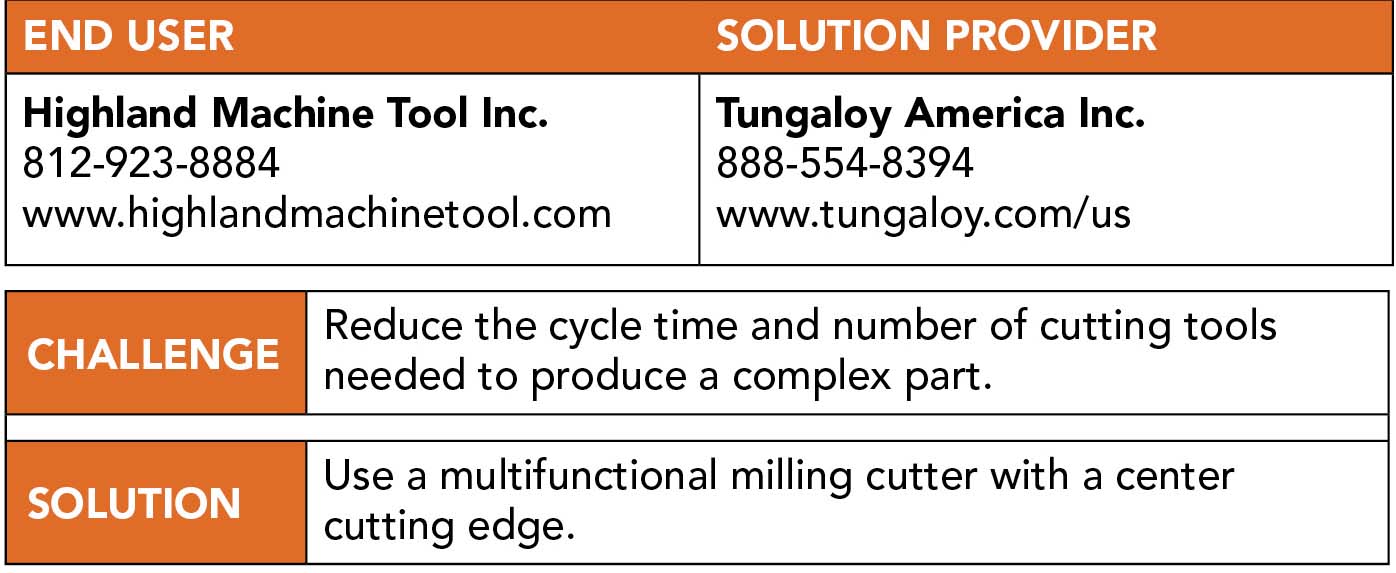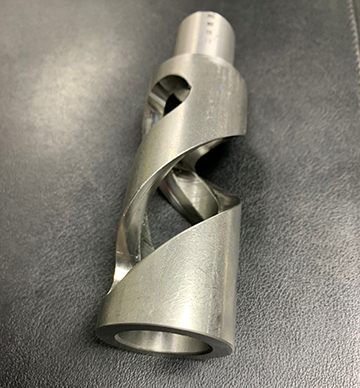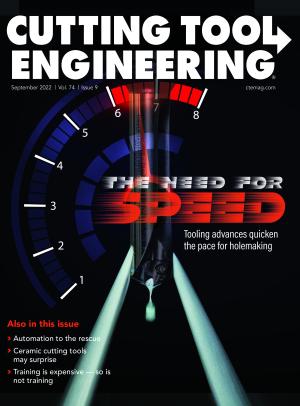It doesn’t take a rocket scientist to realize that a change is needed when machining a part that has a long cycle time while the tool chatters and creates annoying noise.
That was the case at Highland Machine Tool Inc. in Floyds Knobs, Indiana, when machining an adjustment sleeve made of 1018 medium-carbon steel. The cycle time on a vertical machining center was 14 minutes at a cutting speed of 144.8 m/min. (475 sfm), a spindle speed of 2,304 rpm, a feed rate of 0.0254 mm/tooth (0.001 ipt) and a table feed of 175.5 mm/min. (6.91 ipm), according to a test report from Arlington Heights, Illinois-based Tungaloy America Inc., which supplied the milling cutter to solve the challenge.
“It was chattering the old way,” said Brian Sawicki, business development manager for the Northeast at Tungaloy America. “Everybody was complaining in the shop. That machine was loud as heck.”
He said the 38.1 mm-dia. (1.5") workpiece starts on a lathe, where a 25.4 mm-dia. (1") hole is drilled through the center. Previously, holes were drilled through the part wall in four positions after moving it to the VMC, which has a c-axis.

“That is the start position for one of the slots and an end position for one of the slots,” Sawicki explained about each hole. “Then they brought in a center-cutting endmill to — in four passes — open up these slots. I have never seen a part like this before in all my years at Tungaloy.”
He said Highland Machine Tool produces about 800 of the parts per year. Tool life was six parts per tool.
The machine shop purchases a variety of turning tools from Tungaloy America and turned to the toolmaker for a solution after examining options.
Tungaloy America initially tested a replaceable tip-style endmill, but the tool generated “terrible harmonics,” primarily as a result of a long tool overhang, Sawicki said. “It has a carbide shank with a threaded endmill on the end of it.”
In addition, Ron Bender Jr., who performs CNC setup and programming for Highland Machine Tool, said the part had a tendency to spin in the chuck while being cut.
Sawicki explained that the workpiece is held between centers.
“There is a tailstock and a chuck that’s holding the workpiece,” he said. “It’s in free space, lying horizontal and rotating while the tool is rotating in order to create this feature.”
Tungaloy America then tested its DoMultiRec multifunctional milling cutter with a center cutting edge. Sawicki said the team suspected that the overall length of the tool would make it susceptible to chatter. Because the tool body is made of steel, the toolmaker easily shortened the body by 50.8 mm (2").

“We didn’t even try it at its full length,” he said.
Highland Machine Tool still drills the center hole on a lathe before moving the part to the VMC, but the shop uses the DoMultiRec endmill to produce four holes rather than using a drill and then milling the part.
“There were two tools,” Sawicki said, “and they replaced it with one: the DoMultiRec.”
“We used to have to drill the holes for the old endmill,” Bender said. “With this tool, we can do everything. It gets rid of any type of tool change.”
In addition to milling and drilling, Tungaloy America reports that the DoMultiRec is suitable for ramping, pocketing, profiling, slotting, plunging, counterboring and helical interpolation.
By switching to the DoMultiRec, Sawicki said the shop reduced cycle time to 3 minutes, 45 seconds. The cutting speed increased to 182.9 m/min. (600 sfm), the spindle speed increased to 2,910 rpm, the feed rate increased to 0.0838 mm/tooth (0.0033 ipt), and the table feed increased to 487.9 mm/min. (19.21 ipm). As a result, the metal removal rate went from 11,143.2 mm3/min. (0.68 in.3/min.) to 30,971.6 mm3/min. (1.89 in.3/min.).
Tungaloy America calculated a total cost reduction of $24,535 for a batch of 800 parts.
“It saved a lot of money compared to what we were doing,” Bender said.
Contact Details
Related Glossary Terms
- centers
centers
Cone-shaped pins that support a workpiece by one or two ends during machining. The centers fit into holes drilled in the workpiece ends. Centers that turn with the workpiece are called “live” centers; those that do not are called “dead” centers.
- chatter
chatter
Condition of vibration involving the machine, workpiece and cutting tool. Once this condition arises, it is often self-sustaining until the problem is corrected. Chatter can be identified when lines or grooves appear at regular intervals in the workpiece. These lines or grooves are caused by the teeth of the cutter as they vibrate in and out of the workpiece and their spacing depends on the frequency of vibration.
- chuck
chuck
Workholding device that affixes to a mill, lathe or drill-press spindle. It holds a tool or workpiece by one end, allowing it to be rotated. May also be fitted to the machine table to hold a workpiece. Two or more adjustable jaws actually hold the tool or part. May be actuated manually, pneumatically, hydraulically or electrically. See collet.
- computer numerical control ( CNC)
computer numerical control ( CNC)
Microprocessor-based controller dedicated to a machine tool that permits the creation or modification of parts. Programmed numerical control activates the machine’s servos and spindle drives and controls the various machining operations. See DNC, direct numerical control; NC, numerical control.
- counterboring
counterboring
Enlarging one end of a drilled hole. The enlarged hole, which is concentric with the original hole, is flat on the bottom. Counterboring is used primarily to set bolt heads and nuts below the workpiece surface.
- cutting speed
cutting speed
Tangential velocity on the surface of the tool or workpiece at the cutting interface. The formula for cutting speed (sfm) is tool diameter 5 0.26 5 spindle speed (rpm). The formula for feed per tooth (fpt) is table feed (ipm)/number of flutes/spindle speed (rpm). The formula for spindle speed (rpm) is cutting speed (sfm) 5 3.82/tool diameter. The formula for table feed (ipm) is feed per tooth (ftp) 5 number of tool flutes 5 spindle speed (rpm).
- endmill
endmill
Milling cutter held by its shank that cuts on its periphery and, if so configured, on its free end. Takes a variety of shapes (single- and double-end, roughing, ballnose and cup-end) and sizes (stub, medium, long and extra-long). Also comes with differing numbers of flutes.
- feed
feed
Rate of change of position of the tool as a whole, relative to the workpiece while cutting.
- gang cutting ( milling)
gang cutting ( milling)
Machining with several cutters mounted on a single arbor, generally for simultaneous cutting.
- interpolation
interpolation
Process of generating a sufficient number of positioning commands for the servomotors driving the machine tool so the path of the tool closely approximates the ideal path. See CNC, computer numerical control; NC, numerical control.
- lathe
lathe
Turning machine capable of sawing, milling, grinding, gear-cutting, drilling, reaming, boring, threading, facing, chamfering, grooving, knurling, spinning, parting, necking, taper-cutting, and cam- and eccentric-cutting, as well as step- and straight-turning. Comes in a variety of forms, ranging from manual to semiautomatic to fully automatic, with major types being engine lathes, turning and contouring lathes, turret lathes and numerical-control lathes. The engine lathe consists of a headstock and spindle, tailstock, bed, carriage (complete with apron) and cross slides. Features include gear- (speed) and feed-selector levers, toolpost, compound rest, lead screw and reversing lead screw, threading dial and rapid-traverse lever. Special lathe types include through-the-spindle, camshaft and crankshaft, brake drum and rotor, spinning and gun-barrel machines. Toolroom and bench lathes are used for precision work; the former for tool-and-die work and similar tasks, the latter for small workpieces (instruments, watches), normally without a power feed. Models are typically designated according to their “swing,” or the largest-diameter workpiece that can be rotated; bed length, or the distance between centers; and horsepower generated. See turning machine.
- machining center
machining center
CNC machine tool capable of drilling, reaming, tapping, milling and boring. Normally comes with an automatic toolchanger. See automatic toolchanger.
- milling
milling
Machining operation in which metal or other material is removed by applying power to a rotating cutter. In vertical milling, the cutting tool is mounted vertically on the spindle. In horizontal milling, the cutting tool is mounted horizontally, either directly on the spindle or on an arbor. Horizontal milling is further broken down into conventional milling, where the cutter rotates opposite the direction of feed, or “up” into the workpiece; and climb milling, where the cutter rotates in the direction of feed, or “down” into the workpiece. Milling operations include plane or surface milling, endmilling, facemilling, angle milling, form milling and profiling.
- milling cutter
milling cutter
Loosely, any milling tool. Horizontal cutters take the form of plain milling cutters, plain spiral-tooth cutters, helical cutters, side-milling cutters, staggered-tooth side-milling cutters, facemilling cutters, angular cutters, double-angle cutters, convex and concave form-milling cutters, straddle-sprocket cutters, spur-gear cutters, corner-rounding cutters and slitting saws. Vertical cutters use shank-mounted cutting tools, including endmills, T-slot cutters, Woodruff keyseat cutters and dovetail cutters; these may also be used on horizontal mills. See milling.
- profiling
profiling
Machining vertical edges of workpieces having irregular contours; normally performed with an endmill in a vertical spindle on a milling machine or with a profiler, following a pattern. See mill, milling machine.
- shank
shank
Main body of a tool; the portion of a drill or similar end-held tool that fits into a collet, chuck or similar mounting device.
- slotting
slotting
Machining, normally milling, that creates slots, grooves and similar recesses in workpieces, including T-slots and dovetails.
- turning
turning
Workpiece is held in a chuck, mounted on a face plate or secured between centers and rotated while a cutting tool, normally a single-point tool, is fed into it along its periphery or across its end or face. Takes the form of straight turning (cutting along the periphery of the workpiece); taper turning (creating a taper); step turning (turning different-size diameters on the same work); chamfering (beveling an edge or shoulder); facing (cutting on an end); turning threads (usually external but can be internal); roughing (high-volume metal removal); and finishing (final light cuts). Performed on lathes, turning centers, chucking machines, automatic screw machines and similar machines.



